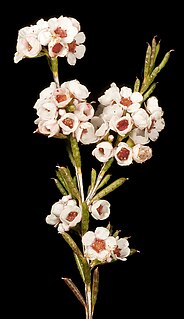
Astartea is a genus of flowering plants in the myrtle family, Myrtaceae. The genus is endemic to southwestern Western Australia. The genus name was inspired by Astarte, the Greek name for the goddess Ishtar.

Thryptomene is a genus of flowering plants in the family Myrtaceae and is endemic to Australia. Plants in the genus Thryptomene are shrubs with small leaves arranged in opposite pairs and white or pink flowers. About forty-seven species of Thryptomene, occurring in all Australian states and the Northern Territory, have been formally described.

Euryomyrtus is a genus of shrubs, in the family Myrtaceae, all of which are endemic to Australia.
Seorsus is a genus of flowering plants in the family Myrtaceae. The occurrence of the four species in Australia and Borneo is widely spaced, and is thought to be indicative that the genus predates the breakup of Gondwana.

Chamelaucieae is a tribe of flowering plants within the family Myrtaceae, mostly from Australia, with a few species in New Caledonia and south-east Asia.
Babingtonia is a genus of flowering plants in the myrtle family, Myrtaceae. The species are native to Australia. Many species formerly placed in the genus are currently included in Sannantha, Baeckea, Oxymyrrhine, Kardomia, Seorsus and Harmogia.

Rinzia is a genus of flowering plants in the family Myrtaceae. The genus was first formally described in 1843 and reinstated and revised in 1986.

Cheyniana is a genus of flowering plants in the family Myrtaceae. Two species are currently recognised, both endemic to Western Australia:

Cyathostemon is a genus of flowering plants in the myrtle family, Myrtaceae. The genus is endemic to southwestern Western Australia. The genus was first described by Nikolai Turczaninow in 1852. Species include:

Dicrastylis is a genus of plants in the Lamiaceae, first described in 1855. The entire genus is endemic to Australia. The type species is Dicrastylis fulva.

Malleostemon is a genus of flowering plants in the myrtle family Myrtaceae, described as a genus in 1983, by John Green The entire genus is endemic to Western Australia.
- Malleostemon costatusRye & Trudgen
- Malleostemon decipiens(W.Fitzg.) Trudgen
- Malleostemon hursthousei(W.Fitzg.) J.W.Green
- Malleostemon microphyllusRye & Trudgen
- Malleostemon minilyaensisJ.W.Green
- Malleostemon nephroideusRye
- Malleostemon nerrenensisRye & Trudgen
- Malleostemon pedunculatusJ.W.Green
- Malleostemon peltiger(S.Moore) J.W.Green
- Malleostemon pustulatusRye
- Malleostemon roseus(E.Pritz.) J.W.Green
- Malleostemon tuberculatus(E.Pritz.) J.W.Green
- Malleostemon uniflorusRye
Ochrosperma is a group of shrubs and small trees in the myrtle family Myrtaceae described as a genus in 1987. The genus is endemic to Australia.
- Ochrosperma adpressumA.R.Bean - Queensland
- Ochrosperma citriodorum(Penfold & J.L.Willis) Trudgen - New South Wales
- Ochrosperma lineare(C.T.White) Trudgen - Queensland, New South Wales
- Ochrosperma obovatumA.R.Bean - Queensland
- Ochrosperma oligomerum(Radlk.) A.R.Bean - New South Wales
- Ochrosperma sulcatumA.R.Bean - Northern Territory

Cyathostemon ambiguus is a member of the family Myrtaceae endemic to Western Australia.
Micromyrtus trudgenii is a plant species of the family Myrtaceae endemic to Western Australia.

Thryptomene australis, commonly known as hook-leaf thryptomene, is a species of flowering plant in the family Myrtaceae and is endemic to the south-west of Western Australia. It is an erect, bushy and spreading shrub with upward-pointing leaves with the tip curving outwards, and flowers with white petals arranged spike-like near the ends of the branchlets.
Thryptomene pinifolia is a species of flowering plant in the family Myrtaceae and is endemic to Kalbarri National Park in Western Australia. It is a shrub with linear leaves, and flowers with pale pinkish sepals and petals and seven or eight stamens.
Barbara Lynette Rye is an Australian botanist born in 1952.
Enekbatus clavifolius is a shrub endemic to Western Australia.
Enekbatus cryptandroides is a shrub endemic to Western Australia.
Malcolm Eric Trudgen is a West Australian botanist. He has published some 105 botanical names. He currently runs his own consulting company, ME Trudgen and Associates.











